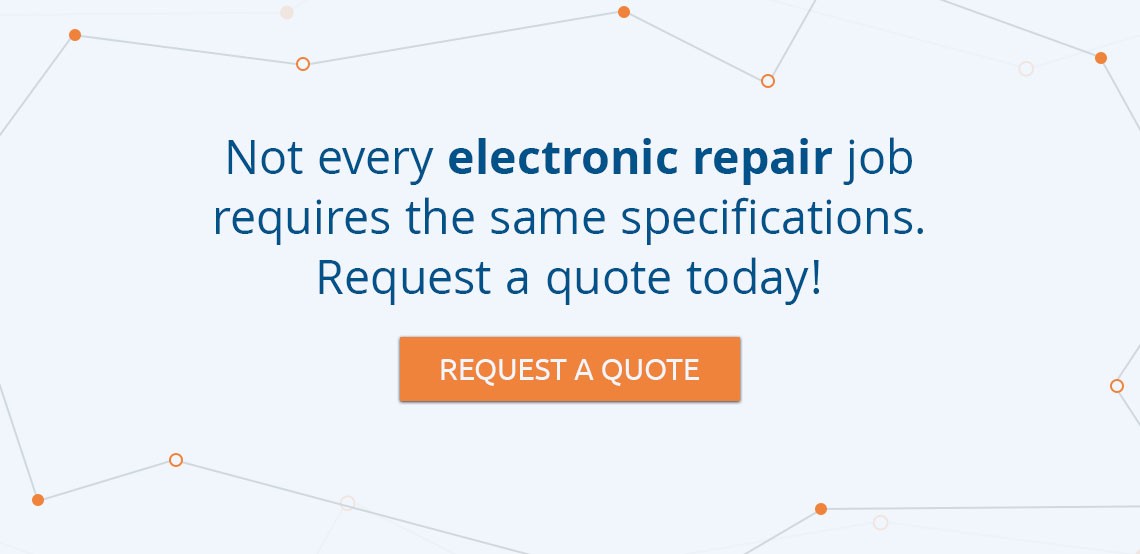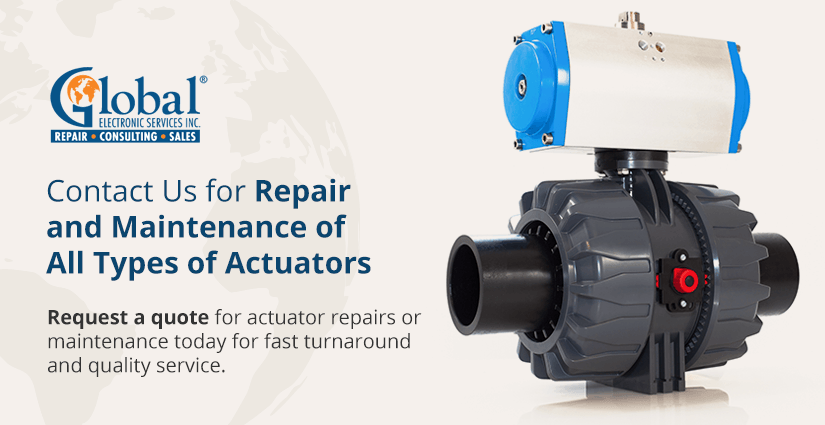Actuators
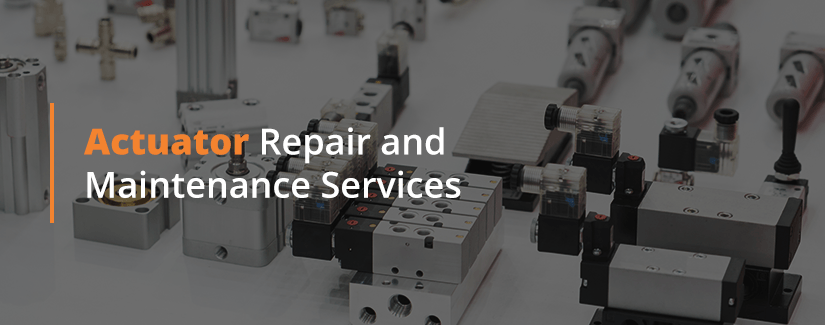
Actuator Repair and Maintenance Services
Our actuator maintenance and repair services for pneumatic and hydraulic types take only a few days to accomplish. Businesses that choose us for actuator repair and care can reduce downtime and increase productivity by getting restored actuators back as quickly as possible.
Our Actuator Maintenance Services
When it comes to repairing and maintaining actuators, our technicians do a variety of services on the devices, including pneumatic actuator maintenance and hydraulic actuator repair. Some of the maintenance services we perform include:
- Rods inspected and repaired: We carefully evaluate the quality of the rods in actuators during maintenance. In cases of damage to the rod exterior, we may chrome the surface to restore its appearance and function.
- Rings and wipers examined: The rings and wipers of the actuators receive careful examination for signs of wear. If our technicians determine the rings’ or wipers’ wear could compromise the operation or efficiency of the actuator, they will replace these components.
- Bushings evaluated: End bushings are another part of actuators that may wear out, even with typical use. Our maintenance includes an inspection of the end bushings and replacement of the parts when needed.
- Seals assessed: Tight seals to prevent leaking fluid or air are crucial to the efficient operation of hydraulic or pneumatic actuators. We look at the seals for proper tightness and replace those that may leak.
- Ports appraised and restored: Technicians look over the actuator’s pressure and return ports. We complete repairs to mitigate any signs of damage and restore full effectiveness.
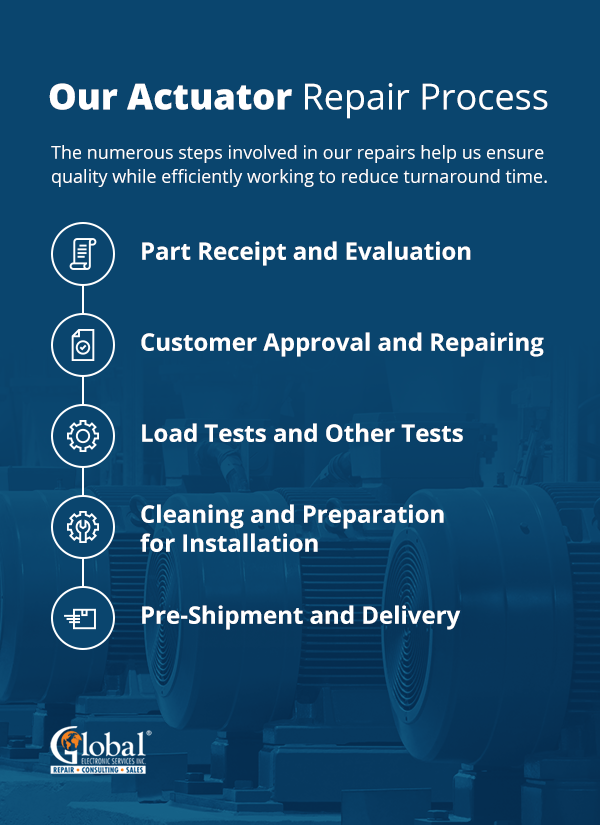
Our Actuator Repair Process
In addition to the maintenance tasks we do, we also provide actuator repairs. The numerous steps involved in our repairs help us ensure quality while efficiently working to reduce turnaround time.
1. Part Receipt and Evaluation
We receive all parts in the mail and start the process by logging them into the system. The intake process includes generating a unique barcode for every part and delivering it to a technician for an evaluation. The tech will evaluate the condition of the part and create an estimate for repairs. We also produce a list of all needed parts for repairing the device. This quote goes to the customer within 24 hours via phone and email for approval.
2. Customer Approval and Repairing
After the customer approves the quote, we assign a technician for repairs. The technician will then disassemble the part and troubleshoot each component. Lastly, they will complete repairs on the unit and put it back together.
3. Load Tests and Other Tests
To ensure the technician correctly repaired the actuator, the part undergoes various tests. First, simulations and true load testing verify that the actuator will operate as intended under normal conditions. These tests show any remaining failure points or components that still need repairs. After completing any remaining repairs the unit needs, it undergoes a final load test to ensure full operation in any condition. Next, the actuator proceeds to the cleaning and shipping steps.
4. Cleaning and Preparation for Installation
Our thorough cleaning process ensures we remove any contaminants from the part. This step also readies the part for reinstallation as soon as your facility receives it.
5. Pre-Shipment and Delivery
Finally, we prepare the actuator for shipping. Our quality assurance team will look over the part, and then packaging will be prepared based on the actuator specifications to ensure safe, secure transit. After we ship the part, we put an invoice online in the Customer Portal for your company to see and pay.
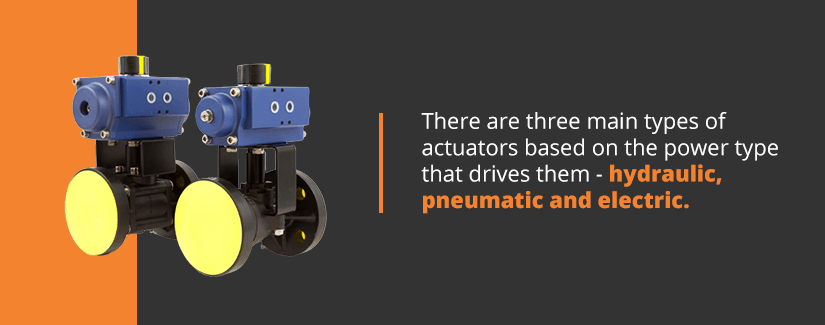
Differences Between Hydraulic, Pneumatic and Electric Actuators
There are three main types of actuators based on the power type that drives them — hydraulic, pneumatic and electric. All forms of actuators turn energy into mechanical motion, either linear or rotary. Essentially, an actuator allows for the automated movement of valves. Each type of actuator has specific benefits, disadvantages and uses:
1. Hydraulic Actuator Pros and Cons
Hydraulic actuators use incompressible fluid to increase force and create movement. One of their biggest benefits is the ability to produce far more force than pneumatic or electric types. Hydraulic motors and pumps can maintain force even over long distances, allowing your company to have the motors and pumps located far from each other. Additionally, the hydraulic actuator does not require more fluid to maintain specific forces.
Hydraulic actuators are not perfect. Their fluid can leak — especially in poorly maintained systems — causing a mess on a factory floor. Also, the need for pumps, heat exchangers, fluid reservoirs and other parts makes systems with hydraulic actuators more complex.
2. Pneumatic Actuator Pros and Cons
Pneumatic actuators operate the same way that hydraulic types do. However, pneumatic models use pressurized air instead of incompressible fluid to create the force needed to generate movement. Because pneumatic actuators don’t use fluid, they cannot cause messy leaks. These actuators require very little maintenance and take up less space than hydraulic models.
The biggest downside of using pneumatic actuators is their lower power production compared to hydraulic types. These actuators cannot generate as much force because their air can compress more than the incompressible liquid used in hydraulic actuators. Another concern with using pneumatic actuators is their size and design. Each pneumatic actuator must be specifically made to produce the needed force for the device it works with. Therefore, pneumatic actuators cannot be used interchangeably with other systems. Over time, pressure loss can occur, and the air may become contaminated with grease from the system.
3. Electric Actuator Pros and Cons
Electric actuators use electrical energy to move parts. These types of actuators offer better precision than hydraulic or pneumatic. They also do not have fluid to leak.
Unfortunately, electric actuators have several issues. First, they cost much more than hydraulic or pneumatic actuators. Additionally, they can overheat through operation, creating wear on the system. These motors also have substantial sizes that can make it difficult to fit into some facilities. The electric operation makes these a dangerous device for environments that prohibit flame hazards or sparks.
Hydraulic and Pneumatic Actuator Uses
The uses for hydraulic and pneumatic actuators relate to their benefits. For instance, electric actuators have a high precision ability, making them ideal for non-hazardous environments that require the most accurate and precise movements:
- Hydraulic actuator uses: Hydraulic actuators provide more force than their pneumatic counterparts. Applications that require the greatest force for moving a valve are ideal for hydraulic actuators. For example, opening or closing a main steam valve would be one of the many uses of a hydraulic actuator.
- Pneumatic actuator uses: Pneumatic actuators don’t generate as much force as hydraulic types. However, these air-powered models provide fast, accurate movements that hydraulic actuators cannot achieve. Because they do not contain fluids or use motors, pneumatic actuators work well in hazardous environments and at extremely high and low temperatures.
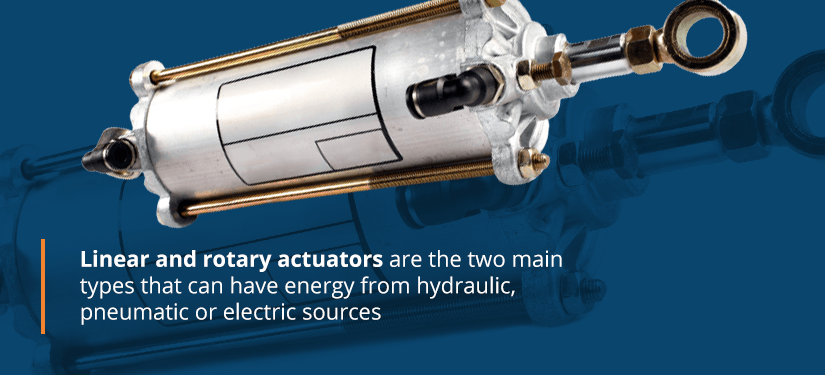
Linear vs. Rotary Actuator
Actuators can generate two main forms of motion, depending on their design. Linear and rotary actuators are the two main types that can have energy from hydraulic, pneumatic or electric sources:
Linear Actuator
Linear actuators create forward motion by pushing a piston into a cylinder under the force from air or fluid. This creates a straight-line motion. This forward motion has long been a staple of automation devices because they can create high amounts of force without heat from an electric motor.
Rotary Actuator
Rotary actuators create a turning or twisting motion. This type of movement can open and close valves or clamps and pick up parts. Three main types of rotary actuators are rack and pinion, scotch yoke and vane.
Rack and pinion types use cylinders to push a rack that causes the pinion to rotate. Scotch yoke designs only create quarter-turn motion. Vane actuators can create turns of a full 360 degrees using vanes inside housing to generate motion.
Frequently Asked Questions About Actuator Repairs and Maintenance
Below, we have answers to some frequently asked questions about our repairs, maintenance services and policies. If you still have questions about technical issues, contact one of our technicians. They will send an email response within 24 hours to 48 hours. For faster responses or to ask questions with more details than you can put into an email, phone us at 1-877-249-1701 and press 1 when you hear the options menu.
1. How Can My Company Receive Actuator Repair?
For repairs, send your actuator to one of our repair facilities with the appropriate packing slip. We will evaluate the device for free, send you a quote and make repairs after you approve the quote. If your company received another quote for the same repairs that is lower than our quote, let us know. We will lower our cost to 10% lower than the competitor’s repair quote.
2. How Soon Can My Company Get the Repaired Actuator Back?
Our repair and maintenance turnaround times average one day to five days. Included in this time is the evaluation process that only lasts 24 hours.
3. Can Our Business Get Rush Service? How Much Does It Cost?
If you need rush service, you can get it for free with a 24-to-48-hour turnaround on the repairs. We help your company minimize its downtime with free rush service, especially from unexpected actuator breakdowns. You must let us know that you need rush service when you send us your actuator.
4. Are Repairs Covered Under a Warranty?
All repairs we conduct have an 18-month warranty after your facility installs and puts the repaired part into service. If your facility saves the repaired actuator as a backup and leaves it in storage, the warranty does not go into effect until your company installs and begins using the repaired actuator to maximize the coverage period.
5. What Is the Shipping Process for Sending Parts for Repair?
The shipping process for repairs or maintenance takes moments. Simply identify the repair facility that services your state using our locations page. Then print out the packing slip for the appropriate East Coast or West Coast facility. Package your actuator and include the packing slip in the box. Then send it to our facility. Even if you need repairs covered under our warranty, you don’t need to complete any other forms aside from the packing slip. We will make the repairs and send it back to your business via the prepaid carrier you choose.
6. What If the Components Are Too Large to Ship?
In some cases, devices are too large for shipping. For such instances, we offer on-site services. When you cannot ship your equipment for maintenance or repairs, contact us to have a technician come to your facility to make the repairs. As with our other services, we work as quickly as possible to reduce downtime for your facility.
7. Do You Have Older or Discontinued Components to Fix Legacy Devices?
Don’t worry if you have older actuators that need repairs. We have parts for older devices, even those out of production. However, if our vast storeroom does not have the brand you need, we will suggest alternative parts with similar specs to fit your actuator during repairs or maintenance.
8. Is Emergency Service Available?
If your business has an emergency that needs addressing after hours or on weekends, phone us at 877-249-1701. We have 24-hour emergency repair technicians who can dispatch on-site service or help with emergencies.
9. What Can My Company Do to Quiet a Noisy Actuator?
Noisy actuators pose a problem for facilities that need to reduce noise pollution or protect employees’ hearing. Noisy operation is a known problem for hydraulic actuators. If possible, replace the actuator with a pneumatic or electric model for quieter operation.
For instances when only a hydraulic actuator will work, check the condition of the pump. Hydraulic pumps with inadequate lubrication, air entering the system or environmental contamination will make noise. If you suspect poor pump upkeep or a similar maintenance problem causes excessive noise, request service for the hydraulic system to get a clear answer.
Contact Us for Repair and Maintenance of All Types of Actuators
Without all components of your facility operating at their peak, your business will lose productivity. Reduce downtime from non-functioning equipment by scheduling repairs with free rush service from us at Global Electronic Services. Through our actuator maintenance, we can extend your company’s equipment life and prevent unanticipated downtime. Request a quote for actuator repairs or maintenance today for fast turnaround and quality service.
